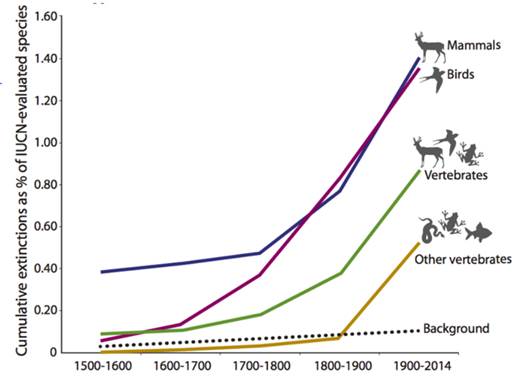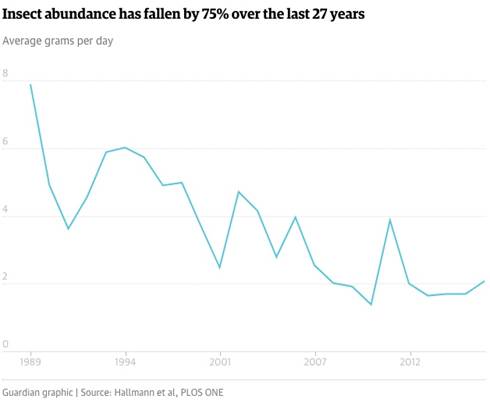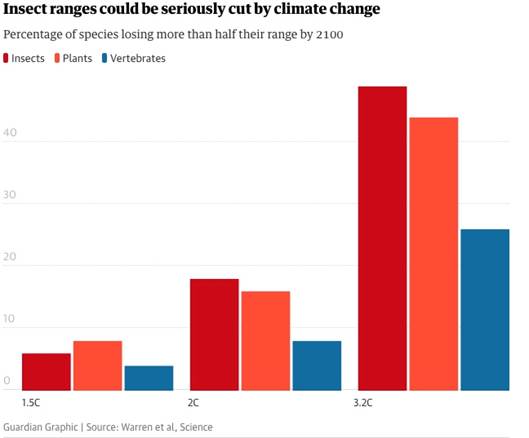Climate Change Mass Extinction - Birds, Bees and Bugs: Going Going Gone
Politics / Climate Change Jun 03, 2018 - 01:08 PM GMTBy: Richard_Mills
 The twitter of birds, the buzzing of bees, the drone of insects are all welcome signs of spring, but could species reduction or extinction, made worse by climate change, mute these sounds to the point where we will have to install apps on our phones to mimic them?
The twitter of birds, the buzzing of bees, the drone of insects are all welcome signs of spring, but could species reduction or extinction, made worse by climate change, mute these sounds to the point where we will have to install apps on our phones to mimic them?
The idea of a silent spring might seem a tad alarmist, but the fate of the world’s wildlife - both land-based and marine - is not looking good. According to research by the World Wildlife Fund and the Zoological Society of London, over the past 40 years the number of wild animals living on Earth has been cut in half. Among the most hard-hit species are forest elephants in central Africa, where deaths by poachers now exceed birth rates, the Hoolock gibbon in Bangladesh, the European meadow and asp vipers, grey partridges in the UK and curlew sandpipers in Australia.
Marine populations have also suffered badly, with sea-based creatures crashing by 40%. The number of turtles has fallen by 80%, due to the destruction of nesting grounds and drowning in fishing nets, said the Guardian, quoting stats from the 2014 report. Scientists blame the destruction of wild habitat on farming, logging and development, for what is seen as the sixth mass extinction of life to occur on our 4 billion-year-old Earth.


Iflscience.com
“Scientists have narrowed down several of the most likely causes of mass extinction. Flood basalt events (volcano eruptions), asteroid collisions, and sea level falls are the most likely causes of mass extinctions, though several other known events may also contribute. These include global warming, global cooling, methane eruptions and anoxic events – when the earth's oceans lose their oxygen.”Mass Extinctions
Every two years, Global Footprint Network, WWF, and the Zoological Society of London publish the Living Planet Report. The Living Planet Report 2016 (October) is an eye opener:
- The Global Living Planet Index shows a decline of 58% between 1970 and 2012 Trend in population abundance for 14,152 populations of 3,706 species monitored across the globe between 1970 and 2012.
- The terrestrial LPI shows a decline of 38% 1970 and 2012 Trend in population abundance for 4,658 populations of 1,678 terrestrial species monitored across the globe between 1970 and 2012.
- The tropical forest species LPI shows a decline of 41 per cent 1970 and 2009 Trend in population abundance for 369 populations of 220 tropical forest species (84 mammals, 110 birds, 10 amphibians and 16 reptiles) monitored across the globe between 1970 and 2009.
- The grassland species LPI shows a decline of 18 per cent between 1970 and 2012 Trend in population abundance for 372 populations of 126 grassland species (55 mammals, 58 birds and 13 reptiles) monitored across the globe between 1970 and 2012.
- The freshwater LPI shows a decline of 81 per cent 1970 and 2012 Trend in population abundance for 3,324 populations of 881 freshwater species monitored across the globe between 1970 and 2012.
- The wetland dependent species LPI shows a decline of 39 per cent between 1970 and 2012 Trend in population abundance for 706 inland wetlands populations of 308 freshwater species (4 mammals, 48 birds, 224 fish, 4 amphibians and 28 reptiles) monitored across the globe between 1970 and 2012.
- The marine LPI shows a decline of 36 per cent between 1970 and 2012 Trend in population abundance for 6,170 populations of 1,353 marine species monitored across the globe between 1970 and 2012.
The Earth has gone through five major extinction events - from the Ordovician-Silurian (350 million years ago), to the Cretaceous-Paleogene (65 million years ago), in each event 70-90% of all species died.
The just started Anthropocene, or the age of the humans, is considered by scientists to be the 6th extinction event. That’s real bad news for humans long before even 50% extinction - loss of species means loss of pollinators - which is a real problem since so many varieties, and so much of our food crops rely on insects (ie. bees) to pollinate.
This article is all about the birds and the bees, and other indicator species that give us clues about how our planet is changing, and not in a good way.
The .01 percenters
The 7.6 billion people living on Earth represent one-tenth of a percent of all living things, yet we have caused the destruction of 83% of all wild mammals and half of plants. This shocking statistic is among recent work published in the Proceedings of the National Academy of Sciences. It’s the first time that scientists have calculated the weight of all living beings. Among the surprising findings that up-end long held assumptions:
- The world is dominated by plants, which make up 82% of all living matter.
- Marine species are actually fewer than thought. They represent just 1% of all biomass. Most of life is land-based and one-eighth is bacteria dwelling underground.
- Viruses have a combined weight three times that of humans.
- Fish have 12 times the global mass of humans and fungi 200 times.
So, despite humanity’s obvious supremacy on the top of the food chain, if the rest of Earth’s animals, plants and bacteria somehow managed to gang up on homo sapiens, it wouldn’t be a fair fight. Humanity would be crushed.

Another interesting finding from the research is that the domestication of animals has significantly depleted wild species. The factory farming of poultry has meant that chickens now make up 70% of all birds, while 60% of mammals are livestock, mostly cattle and pigs. Only 4% are wild animals.
The transformation of the planet into one that has been molded by human activity has led to the creation of a new geological era known as the Anthropocene, which scientists trace back to the 1950s, when major changes to the Earth began to take place, including the dispersion of radiation from nuclear bomb testing, the beginning of mass plastic pollution, and emissions from power stations.
The current epoch, the Holocene, is the 12,000 years of stable climate since the last ice age during which all human civilisation developed. But the striking acceleration since the mid-20th century of carbon dioxide emissions and sea level rise, the global mass extinction of species, and the transformation of land by deforestation and development mark the end of that slice of geological time, the experts argue. The Earth is so profoundly changed that the Holocene must give way to the Anthropocene. - The Guardian
Those on side with this believed ‘the influence of humanity on the Earth's atmosphere and crust in the last few centuries is so significant as to constitute a new geological epoch.’
The big question is “What do we use for the start date?”
The Anthropocene study group is considering several proposed markers:
- Radionuclides left over from atomic bombs in the 1940s and 1950s. The advantage these nuclear markers have over all the other proposed markers is that plutonium, caesium, strontium etc. can all be linked to a specific date in time as well as a clear line in rock.
- The widespread use of plastic.
- The release of poly-aromatic hydrocarbons from burning fossil fuels.
- And last but not least, lead contamination from petroleum.
All leave their own very distinctive telltale traces in the Earth’s rocks.
“Whenever the new epoch started, we’re living in it now. And if our descendants look back in thousands of years’ time, they’ll see the evidence of our actions written everywhere in the rocks.” Anthropocene.info
Rocks are used to define the different time periods in Earth’s history. For example - the start of the Cambrian period marks the moment in time when major groups of animals first appeared as fossils in rocks.

World Wildlife Federation
The Global Living Planet Index (LPI), shows a decline of 52 per cent between 1970 and 2010. The LPI is based on trends in 10,380 populations of 3,038 mammal, bird, reptile, amphibian and fish species.
The global LPI tells us that more than half of the world's vertebrates disappeared between 1970 and 2010.
I suggest ‘Anthropocene time mark – 1970.’
After all, if the start of the Cambrian period marks the moment in time when major groups of animals started to appear in the fossil record why not use 1970 for the start of the Anthropocene, you know, define the moment when they started to disappear?
Birds
The seasons come and go, and birds have always adjusted to the warming climate to lay eggs and nest at the perfect time to ensure they always have enough food to rear their young. But climate change is throwing a wrench into the seasonal migrational patterns of birds. Studying the interval between spring plant growth and the arrival of 48 North American bird species between 2001 and 2012, researchers at Memorial University in Newfoundland and Florida’s Museum of Natural History found the gap is growing at a rate of one day a year. Some bird species can adapt to the change, by arriving earlier, but those who can’t are having problems. They are missing the chance to find good nesting spots or to feed on insects. Among the species struggling to keep up with early springs are great-crested flycatchers, indigo buntings, northern parulas, blue-winged warblers and Townsend's warblers, CBC reported. The result means that fewer birds are likely to survive, reproduce and return the next year.
Bird population declines have also resulted from loss of habitat, due to wetlands being drained for farming or development. In the UK, of the most common birds, 16 species have declined by over a third since 1995.
Bees
Bees are considered one of the most important indicator species due to the crucial role they play in plant pollination. It’s been estimated that one out of every three bites of food is made possible by bees and other pollinators - with honeybees pollinating some $15 billion worth of crops each year. Bees from one hive can collect pollen from up to 100,000 flowering plants, daily.
However according to Conservation International (CI), 10 million hives have disappeared from 2014-17.
What’s causing bees to die off? There are various theories, but among the most likely culprits are habitat loss, shifting temperatures, and disease. Due to warming, bees are not migrating to cooler areas to establish new hives. There are almost 200 miles less in the way of bee territories in North America according to a recent study. Bees are finding a mismatch between when the pollen arrives and when they feed on pollen. According to CI, even a mismatch of 3 days can make bees less likely to reproduce and less resistant to predators or parasites.
Less healthy bees make them more susceptible to infections, like Varroa mites and the gut parasite Nosema ceranae.
A feature article in Rolling Stone discusses the role of insecticides in killing off bee populations. Blame is laid on a new class of insecticides known as neonicotinoids, or neonics, that started being used intensively on crops in the early 2000s. The insecticide compound is easily applied to plants, making them more resistant to predators, but it also damages the brains of bees.
That neonic insecticides can kill honeybees is not up for debate. If an unlucky bee flies into a cloud of dust kicked up when coated seeds are planted, she'll die on the spot. - Rolling Stone
"The chess-board is the world; the pieces are the phenomena of the universe; the rules of the game are what we call the laws of Nature. The player on the other side is hidden from us. We know that his play is always fair, and patient. But also we know, to our cost, that he never overlooks a mistake, or makes the smallest allowance for ignorance." Thomas Henry Huxley, biologist
Many vegetables, fruits, nuts, legumes and seed crops are dependent on pollination and that service is provided mostly by bees - one of the most important global pollinators of native plants.
“The way humanity manages or mismanages its nature-based assets, including pollinators, will in part define our collective future in the 21st century. Human beings have fabricated the illusion that in the 21st century they have the technological prowess to be independent of nature. Bees underline the reality that we are more, not less, dependent on nature’s services in a world of close to seven billion people." Achim Steiner, UN Undersecretary-General and UNEP’s Executive Director
The bumblebee is disappearing – bumblebee numbers are declining in Europe, Asia and North America. Honey bees are also disappearing at an alarming rate - colony loss in North America, since 2004, has resulted in fewer managed pollinators than any other time during the last fifty years.
Bugs
The idea of insects dying through global warming doesn’t evoke the same reaction as if it were koala bears, but the impacts are much more serious. Insects are vital to the cycle of plant pollination; many fruits crops and wild plants are insect-pollinated. Insects also form the bottom of multiple food chains and their loss or reduction has repercussions up the line, for example on birds that feed on them.
So why are insect numbers declining? A big reason has to do with pesticide-based agriculture, where a variety of poisonous chemicals are dusted over crops to prevent insects from eating them and affecting farmers’ yields. In 2016 scientists warned of an “ecological Armagaddon” after discovering that three-quarters of flying insects in Germany and likely elsewhere had perished over the last 25 years.

The losses are said to be compounded by global warming, which causes habitat destruction. A recent analysis published in the journal Science compared the geographic ranges and climate conditions of 31,000 insect species, 8,000 birds, 1,700 mammals, 1,800 reptiles, 1,000 amphibians and 71,000 plants. The study found that when the temperature warmed up to a certain point, some regions could no longer support some species. Climate change could make nearly half of insect habitat unsuitable by 2100, states a May 2018 Guardian article.

Some insects are also getting smaller. Ecology students at UBC in Vancouver found that 22 beetle species shrank when raised in warmer than normal temperatures - the snail killing carabid beetle has shrunk 20% in the last 45 years.
Conclusion
Indicator species - birds, bees and bugs - are like the proverbial canary in a coal mine. Problems with these animals are a sign that our planet could be in trouble. For the proper functioning of the ecosystem, we need our birds, our bugs and our bees to survive and thrive. This requires smart management of the available land base which of course face pressures from increasing populations, domesticated animals and development, particularly urban sprawl. We one-tenth percenters might be at the top of the food chain, but as Uncle Ben in Spiderman said, “with great power comes great responsibility” to ensure that those underneath us continue to populate the Earth even as it experiences ecological changes.
Our changing climate- Part 1
Birds, bees and bugs: going going gone - Part 2
Gone Fishing – Part 3
The day they turned off the taps – Part 4
Climate change is already impacting you and the consequences you feel are going
to intensify and multiply. Are birds, bees and bugs on your radar screen?
If not, maybe it should be.
By Richard (Rick) Mills
If you're interested in learning more about the junior resource and bio-med sectors please come and visit us at www.aheadoftheherd.com
Site membership is free. No credit card or personal information is asked for.
Richard is host of Aheadoftheherd.com and invests in the junior resource sector.
His articles have been published on over 400 websites, including: Wall Street Journal, Market Oracle, USAToday, National Post, Stockhouse, Lewrockwell, Pinnacledigest, Uranium Miner, Beforeitsnews, SeekingAlpha, MontrealGazette, Casey Research, 24hgold, Vancouver Sun, CBSnews, SilverBearCafe, Infomine, Huffington Post, Mineweb, 321Gold, Kitco, Gold-Eagle, The Gold/Energy Reports, Calgary Herald, Resource Investor, Mining.com, Forbes, FNArena, Uraniumseek, Financial Sense, Goldseek, Dallasnews, Vantagewire, Resourceclips and the Association of Mining Analysts.
Copyright © 2018 Richard (Rick) Mills - All Rights Reserved
Legal Notice / Disclaimer: This document is not and should not be construed as an offer to sell or the solicitation of an offer to purchase or subscribe for any investment. Richard Mills has based this document on information obtained from sources he believes to be reliable but which has not been independently verified; Richard Mills makes no guarantee, representation or warranty and accepts no responsibility or liability as to its accuracy or completeness. Expressions of opinion are those of Richard Mills only and are subject to change without notice. Richard Mills assumes no warranty, liability or guarantee for the current relevance, correctness or completeness of any information provided within this Report and will not be held liable for the consequence of reliance upon any opinion or statement contained herein or any omission. Furthermore, I, Richard Mills, assume no liability for any direct or indirect loss or damage or, in particular, for lost profit, which you may incur as a result of the use and existence of the information provided within this Report.
© 2005-2022 http://www.MarketOracle.co.uk - The Market Oracle is a FREE Daily Financial Markets Analysis & Forecasting online publication.



